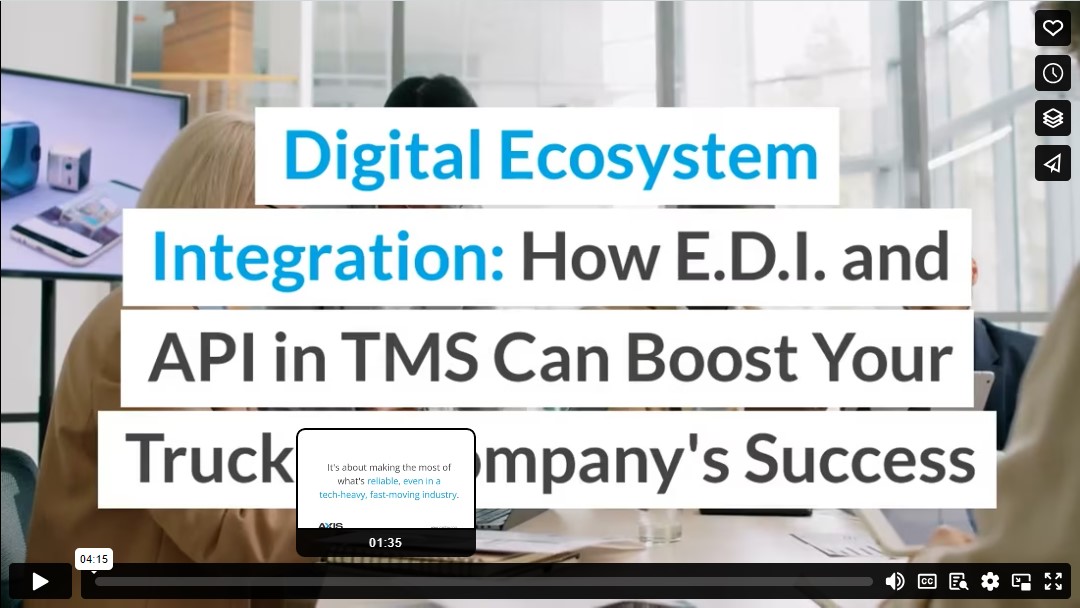Got a headache from all the paperwork and disjointed systems in your trucking business? It’s time to switch things up. Hooking up your transportation management system (TMS) with some smart tech like EDI (Electronic Data Interchange) and API (Application Programming Interface) can really smooth things out. This means less mess with your operations and better talking between your systems.
EDI’s Role in TMS
EDI, or Electronic Data Interchange, is like the old reliable system-to-system communication in the trucking world. It’s been around for a while, but don’t let its age fool you. EDI is great at cutting down on paper and manual data entry, which means fewer mix-ups in your communications. Big players, especially large retailers and major organizations, still rely on it for key transportation tasks. These include sending load tenders, updating statuses, and handling invoices.
Here’s how it works in action: say a large retail customer has a load to send. Their system whips up an EDI version of this load tender. Then, they send it over to you, the carrier or broker. Your software turns this into a document you can actually work with. You then get to choose: take the load or pass on it. And you send back your response.
EDI is speedy and reliable for passing information back and forth. The catch? Setting it up can be a bit of a project. It involves a lot of coordination with different people and getting into the nitty-gritty of technical details. You’re not just making documents readable by computers, but also making sure they meet specific standards. Plus, you might find yourself juggling multiple vendors at the same time.
So, when you tie EDI into your TMS, you’re plugging into a proven system. It’s about making the most of what’s reliable, even in a tech-heavy, fast-moving industry.
API’s role in TMS
API, or Application Programming Interface, is the next step in the evolution of trucking tech. APIs let you automate almost any action that someone could do manually in software. And they can be integrated with other systems to not just share, but also edit data. Imagine you usually input an order and dispatch it to a driver by hand. An API can be set up to handle all these steps automatically.
When it comes to TMS, APIs are a big deal. They’re like a toolkit of automation tricks specifically for trucking tasks. Plus, they offer smooth plug-and-play connections with other apps you depend on. For instance, when you generate bills or invoices, an API can automatically send them to accounting software like QuickBooks. APIs also make things like border crossings and compliance for trucking companies easier by linking up with business tools.
Another cool thing about APIs is that your partners and customers can create programs that work directly in their own apps. For example, a broker could set up a system to dispatch orders instantly to a partner carrier’s drivers.
The possibilities with an API are only limited by the creativity and skill of the programmers. When APIs communicate with each other, trucking companies unlock a world of efficiency.
APIs shine when your customers want to automate routine tasks with you. This could be order flows, real-time tracking, or invoice exchanges. They are flexible and customizable, offering up-to-the-minute data that works with various software and platforms. This means everything is transparent and runs at peak efficiency. Also, APIs are often more budget-friendly than EDI. They don’t need constant upkeep or special translation services. Implementing an API sets you apart as a forward-thinking service provider in the trucking industry.
The Intersection for Success
Integrating both EDI and API in your TMS is like hitting the sweet spot for your trucking business. EDIs are your go-to for zipping through all those routine business papers, while API is the genius making sure your systems work together seamlessly.
Here’s the deal:
- Gets things moving faster: With info swapping in real time and tasks running on auto, your whole operation gets slicker and quicker.
- Keeps you on track: No more headaches about rules or messing up paperwork. Everything’s precise and up to code, automatically.
- Keeps customers happy: Your clients get the lowdown exactly when they need it. That builds trust and keeps them coming back.
- Saves money: Automating stuff like entering data and handling documents means you spend less on the grind work.
Bottom line? Merging EDI and API into your TMS isn’t just about getting with the times. It’s about building a digital powerhouse that takes your trucking business to the next level in efficiency, compliance, and customer satisfaction. That’s how you stay ahead in the industry.
Video


